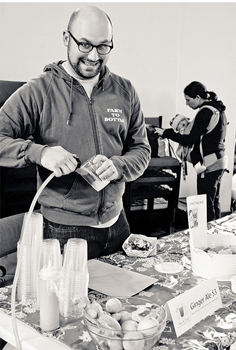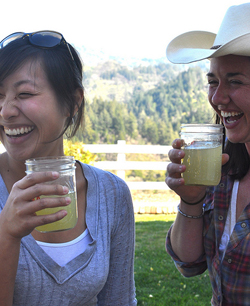Local Fizz
June 3, 2011
 Jesse Friedman is doing his part to create a soda renaissance in San Francisco. Of course, this blogger-turned-beverage-connoisseur isn’t interested in just any soda. To the contrary, he plans to fill the space normally occupied by your standard sugar-saturated pop with seasonal, yeast-fermented soda made with local produce.
Jesse Friedman is doing his part to create a soda renaissance in San Francisco. Of course, this blogger-turned-beverage-connoisseur isn’t interested in just any soda. To the contrary, he plans to fill the space normally occupied by your standard sugar-saturated pop with seasonal, yeast-fermented soda made with local produce.
“I’m interested in taking the vocabulary and the ideas that really drive a lot of modern San Francisco cuisine — i.e., seasonal, healthy, farmers market-driven, and focused on sustainable practices and strong flavors – and applying those exact same ideas to soda,” he says.
This month Freidman, who has blogged regularly at Beer and Nosh for the last three years, is leaving a career in information technology to pursue two new businesses: beer (under the name Almanac Beer Co.) and soda (SodaCraft). For the last few months he’s been serving his fermented sodas from inside the Hapa Ramen booth at the Ferry Plaza on occasional Saturdays and, starting soon, he’ll have a tent of his own at the Thursday market.
What exactly is the difference between yeast-fermented soda and the kind you find at the corner store? As Friedman describes it, one answer lies in carbonation. Most modern soda is made bubbly by combining carbon dioxide and water under high pressure. “You end up with a pretty aggressive, biting character to the carbonation,” he says. “It doesn’t add anything to the flavor.” In contrast, Friedman ferments his soda for around 24 hours using baker’s yeast. “It adds a lot of flavor and a rich, silky texture to the soda. It also creates a nice yeasty aroma and a lot of complexity. It’s actually, in a lot of ways, similar to the methods used to carbonate good champagne.” Friedman’s beverages also have fewer calories and a lot less sugar than conventional soda (currently around seven percent of the average American’s caloric intake).
And then there are the ingredients. Every gallon of SodaCraft ginger ale is made with a pound of fresh, local ginger. Friedman adds the juice of local Eureka lemons, organic cane sugar, and then water and baker’s yeast. In addition to the ginger ale, which he intends to serve all year round, he plans to offer at least one seasonal fruit-based soda. This winter it was orange fennel, and since spring began he’s been serving a smoked strawberry-vanilla flavor that he’s pretty proud of.
 The challenges? The fresh ingredients and unique fermentation process give the SodaCraft sodas a shelf life of only around a week. “You can’t just stick it under a bar and leave it alone like another soda,” he says. “That’s why they’re perfectly suited for farmers markets. We brew them for a specific day and then serve them on that day. The process is a lot like what a food vendor goes through.” Taking on the financial risk associated with a perishable product means growing the business cautiously. In addition to the Ferry Plaza, Jesse plans to begin serving his soda – a perfect companion to street food – at Off the Grid events this summer. But it may be a while before Friedman can afford to hire any help. “The math works out great right up until I have to start paying someone else,” he says.
The challenges? The fresh ingredients and unique fermentation process give the SodaCraft sodas a shelf life of only around a week. “You can’t just stick it under a bar and leave it alone like another soda,” he says. “That’s why they’re perfectly suited for farmers markets. We brew them for a specific day and then serve them on that day. The process is a lot like what a food vendor goes through.” Taking on the financial risk associated with a perishable product means growing the business cautiously. In addition to the Ferry Plaza, Jesse plans to begin serving his soda – a perfect companion to street food – at Off the Grid events this summer. But it may be a while before Friedman can afford to hire any help. “The math works out great right up until I have to start paying someone else,” he says.
In the end, Jesse hopes to shift the role beverages play in the local food system. “People have very specific thoughts about the ways food should be sourced and prepared, and then they get excited to have a Mexican Coke with it,” he says. “We’re trying to extend that attitude (to drinks), because — just like with food — fresh, local ingredients make a much better, healthier product.”
Photo of Jesse Friedman by Jordan Ching. Photo of smiling soda drinkers by Jesse Friedman.
Topics: Food makers
